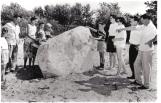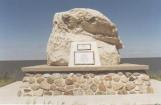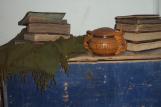1
The first non-native settlers arrived in the Gimli area on October 21, 1875. This group of about 235* Icelanders formed the beginnings of the present community. Immigration was almost exclusively from Iceland for the next 22 years. In 1895 a trickle of immigrants from the Ukraine settled in the area and by 1897 the area was opened up to any immigrant wishing to settle in the area. Immigrants from Iceland and Ukraine continued to arrive and others from Poland and to a lesser extent Germany and Hungary dominated the new immigration but other Canadians and new immigrants arrived as well.* Two hundred and eighty-five had intended on moving to the new settlement but approximately 50 stayed in Winnipeg to find employment for the first winter.
3
This painting depicts the landing of the Icelandic settlers at Willow Point on October 21, 1875 after an arduous trip from Kinmount, Ontario. The final leg of the trip was by flat boat and York boat down the Red River from Winnipeg to Lake Winnipeg. These boats were towed by the steamer the Colville from from the mouth of the Red River onto the rough waters of fall on Lake Winnipeg. Weather conditions prevented the group from reaching their intended destination 20 plus miles north of their landing site and resulted in the establishment of their new community near the southern edge of the land grant.5
Shortly after their landing on Willow Point , a woman giving birth used a large white rock on the beach as shelter from a late October storm. The white rock has become an enduring symbol of the hardships and triumphs of the first Icelandic settlers to arrive in the area.The baby born on the beach was named Jon Johansson, and he lived his entire life in Gimli (pictured here circa 1900). Today, one hundred and thirty years later, many of Jon's descendants still live in the area and the original walls of a log cabin built by Jon as a young man, can be seen as part of a dynamic diorama at the New Iceland Heritage Museum in Gimli.






